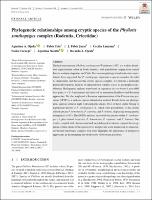| dc.creator | Ojeda, Agustina Alejandra | |
| dc.creator | Teta, Pablo Vicente | |
| dc.creator | Jayat, Jorge Pablo | |
| dc.creator | Lanzone, Cecilia | |
| dc.creator | Cornejo, Paula | |
| dc.creator | Novillo, Agustina | |
| dc.creator | Ojeda, Ricardo Alberto | |
| dc.date.accessioned | 2023-08-25T12:08:42Z | |
| dc.date.available | 2023-08-25T12:08:42Z | |
| dc.date.issued | 2021-01-12 | |
| dc.identifier.citation | Ojeda, A.A., Teta, P.V., Jayat, J.P., Lanzone, C., Cornejo, P., Novillo, A. y Ojeda, R.A. (2022). Phylogenetic relationships among cryptic species of the phyllotis xanthopygus complex (rodentia, cricetidae). Zoologica Scripta. Reino Unido: Wiley Blackwell Publishing, 50 (3), pp. 1-13. | es_AR |
| dc.identifier.issn | 0300-3256 | |
| dc.identifier.other | 27040 | |
| dc.identifier.other | CCPI-CNyE-A-128 | |
| dc.identifier.uri | https://hdl.handle.net/20.500.12219/5090 | |
| dc.description | Fil: Ojeda, Agustina Alejandra. Consejo Nacional de Investigaciones Científicas y Técnicas. Instituto Argentino de Investigaciones de las Zonas Áridas (Mendoza); Argentina. | es_AR |
| dc.description | Fil: Ojeda, Agustina Alejandra. Universidad Nacional de Cuyo. Instituto Argentino de Investigaciones de las Zonas Áridas (Mendoza); Argentina. | |
| dc.description | Fil: Teta, Pablo Vicente. Museo Argentino de Ciencias Naturales “Bernardino Rivadavia”. División Mastozoología; Argentina. | |
| dc.description | Fil: Jayat, Jorge Pablo. Consejo Nacional de Investigaciones Científicas y Técnicas. Centro Científico Tecnológico (Tucumán). Unidad Ejecutora Lillo; Argentina | |
| dc.description | Fil: Lanzone, Cecilia. Consejo Nacional de Investigaciones Científicas y Técnicas. Instituto de Biología Subtropical. Laboratorio de Genética Evolutiva; Argentina. | |
| dc.description | Fil: Lanzone, Cecilia. Universidad Nacional de Misiones. Instituto de Biología Subtropical. Laboratorio de Genética Evolutiva; Argentina. | |
| dc.description | Fil: Cornejo, Paula. Consejo Nacional de Investigaciones Científicas y Técnicas. Instituto Argentino de Investigaciones de las Zonas Áridas (Mendoza); Argentina. | |
| dc.description | Fil: Cornejo, Paula. Universidad Nacional de Cuyo. Instituto Argentino de Investigaciones de las Zonas Áridas (Mendoza); Argentina. | |
| dc.description | Fil: Novillo, Agustina. Consejo Nacional de Investigaciones Científicas y Técnicas. Centro Científico Tecnológico (Tucumán). Instituto de Biodiversidad Neotropical; Argentina. | |
| dc.description | Fil: Novillo, Agustina. Universidad Nacional de Tucumán. Instituto de Biodiversidad Neotropical; Argentina. | |
| dc.description | Fil: Ojeda, Ricardo Alberto. Consejo Nacional de Investigaciones Científicas y Técnicas. Instituto Argentino de Investigaciones de las Zonas Áridas (Mendoza); Argentina. | |
| dc.description | Fil: Ojeda, Ricardo Alberto. Universidad Nacional de Cuyo. Instituto Argentino de Investigaciones de las Zonas Áridas (Mendoza); Argentina. | |
| dc.description.abstract | The leaf-eared mouse, Phyllotis xanthopygus (Waterhouse 1837) is a widely distributed sigmodontine rodent in South America, with populations ranging from central Peru to southern Argentina and Chile. Previous morphological and molecular contributions have suggested that P. xanthopygus represents a species complex. In order to characterize and disclose this cryptic species complex, we perform a molecular genetic/phylogenetic analysis of representative samples across its geographical distribution. Phylogenetic analyses were based on sequences of cytochrome-b gene (801 base pairs; n = 114 specimens) and analysed by maximum likelihood and Bayesian approaches. We also employed a Bayesian implementation of the Poisson tree processes (bPTP) as a unilocus species delimitation method. Results from our phylogenetic analyses retrieve eight well-supported clades. Five of these clades belong to populations known as P. xanthopygus s.l., which were paraphyletic to the closely
related species P. bonariensis, P. caprinus, and P. limatus, displaying strong genetic divergences (>8%). The (bPTP) analyses recovered ten species within P. xanthopygus s.l. plus related forms (i.e. P. bonariensis, P. caprinus, and P. limatus). Our results, coupled with chromosomal and morphological evidences, support the recognition of these clades at the species level and provide a new framework to characterize the leaf-eared mice complex. Our study highlights the importance of integrative approaches in disentangling the biodiversity of Neotropical rodents. | es_AR |
| dc.format | application/pdf | |
| dc.format.extent | 1.2 MB | |
| dc.language.iso | eng | es_AR |
| dc.publisher | Wiley Blackwell Publishing | es_AR |
| dc.relation | info:eu-repo/semantics/altIdentifier/hdl/http://hdl.handle.net/11336/153384 | |
| dc.relation | info:eu-repo/semantics/altIdentifier/doi/http://dx.doi.org/10.1111/zsc.12472 | |
| dc.rights | info:eu-repo/semantics/openAccess | |
| dc.subject | Taxonomy | es_AR |
| dc.subject | Phylogeny | es_AR |
| dc.subject | Rodentia | es_AR |
| dc.subject | Myomorpha | es_AR |
| dc.subject | Sigmodontinae | es_AR |
| dc.subject | South America | es_AR |
| dc.title | Phylogenetic relationships among cryptic species of the phyllotis xanthopygus complex (rodentia, cricetidae) | es_AR |
| dc.type | info:eu-repo/semantics/article | es_AR |
| dc.type | info:ar-repo/semantics/artículo | |
| dc.type | info:eu-repo/semantics/publishedVersion | |



